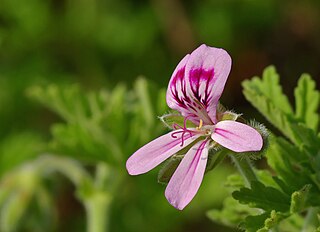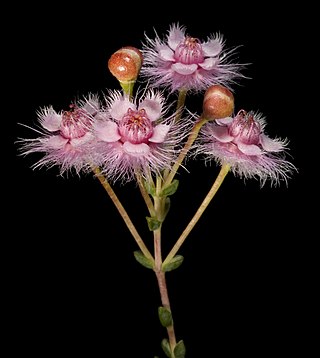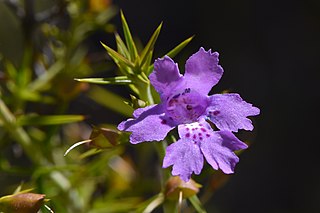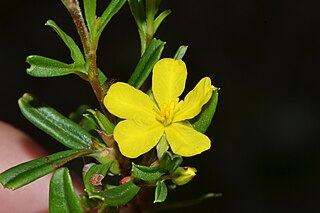
Pelargonium is a genus of flowering plants that includes about 280 species of perennials, succulents, and shrubs, commonly called geraniums, pelargoniums, or storksbills. Geranium is also the botanical name and common name of a separate genus of related plants, also known as cranesbills. Both genera belong to the family Geraniaceae. Carl Linnaeus originally included all the species in one genus, Geranium, and they were later separated into two genera by Charles Louis L'Héritier de Brutelle in 1789.

Hibbertia stellaris, commonly known as star guinea flower or orange stars, is a brilliantly orange flowering ground cover from the South Western Australian botanical province. It naturally grows in swamps; despite this, it is extremely sensitive to phytophthora and needs to be grown in well-drained soil in cultivation.

Charles von Hügel, sometimes spelt in English Huegel, was an Austrian nobleman, army officer, diplomat, botanist, and explorer, now primarily remembered for his travels in northern India during the 1830s. During his lifetime he was celebrated by the European ruling classes for his botanical garden and his introduction of plants and flowers from New Holland (Australia) to Europe's public gardens.

Pelargonium graveolens is a Pelargonium species native to the Cape Provinces and the Northern Provinces of South Africa, Zimbabwe and Mozambique.

Hardenbergia is a genus of three species of flowering plants in the pea family, Fabaceae and is endemic to Australia. Plants in this genus are climbing or trailing herbs or subshrubs with pinnate leaves with one, three or five leaflets and groups of violet, white or pinkish flowers in pairs or small clusters in leaf axils. Species of Hardenbergia occur in all Australian states and in the Australian Capital Territory.

Melaleuca huegelii, commonly known as chenille honey-myrtle, is a plant in the myrtle family, Myrtaceae and is endemic to the south-west coastal areas of Western Australia. It has small, almost scale-like leaves and flower spikes sometimes more than 100 millimetres (4 in) long on the ends many of its branches.

Pelargonium drummondii is a species of Pelargonium found around the southern coasts of Western Australia.

Verticordia insignis is a species of flowering plant in the myrtle family, Myrtaceae and is endemic to the south-west of Western Australia. It is an open, irregularly-branched shrub with small leaves and heads of relatively large pink, or white and pink flowers on the ends of the branches in spring.

Darwinia citriodora, commonly known as lemon-scented darwinia or lemon scented myrtle, is a plant in the myrtle family Myrtaceae and is endemic to the south-west of Western Australia. It is a shrub with oblong to lance-shaped leaves and red, yellow and orange flowers over an extended period. It is a hardy plant in well-drained soil, is often cultivated and used as a rootstock for less hardy species.

Verticordia pennigera, commonly known as native tea, is a flowering plant in the myrtle family, Myrtaceae, and is endemic to the south-west of Western Australia. It is usually a small erect or prostrate shrub with small leaves and lightly-scented spikes of pale pink to magenta-coloured flowers in spring.
Enumeratio plantarum quas in Novae Hollandiæ ora austro-occidentali ad fluvium Cygnorum et in sinu Regis Georgii collegit Carolus Liber Baro de Hügel is a description of the plants collected at the Swan River colony and King George Sound in Western Australia. The author, Stephan Endlicher, used a collection arranged by Charles von Hügel to compile the first flora for the new settlements. Hugel visited the region during 1833–1834, several years after the founding of the colony. The work provided formal descriptions, in Latin, of new species and genera of plants. The single instalment was produced in Europe by Endlicher in 1837, the work also included contributions by Eduard Fenzl, George Bentham, Heinrich Wilhelm Schott.

Pelargonium capitatum is one of several species known as rose geranium or rose-scented pelargonium in English. The popular names refer to the scent of the essential oils extracted from glandular tissue, not the flowers, which have hardly any scent to speak of. Some of the species are known as kusmalva in Afrikaans.

Scaevola canescens is a species of plant in the family Goodeniaceae. It is endemic to Western Australia where it occurs "from Shark Bay to Perth, in open forest and heath in sandy soil".

Hemiandra linearis, commonly known as speckled snakebush, is a species of prostrate to ascending shrub that is endemic to the south-west of Western Australia.

Comesperma integerrimum is a twining shrub or climber in the family Polygalaceae.

Hibbertia perfoliata is a species of flowering plant in the family Dilleniaceae and is endemic to Western Australia. It is a weak, ascending or prostrate, spreading shrub that typically grows to a height of up to 40 cm (16 in). It flowers from September to December or from January to March and has yellow flowers. The species was first formally described in 1837 by Stephan Endlicher from an unpublished description by Charles von Hügel and Endlicher's description was published in his book Enumeratio plantarum quas in Novae Hollandiae ora austro-occidentali ad fluvium Cygnorum et in sinu Regis Georgii collegit Carolus Liber Baro de Hügel. The specific epithet (perfoliata) means "perfoliate".

Hibbertia racemosa, commonly known as stalked guinea flower, is a species of flowering plant in the family Dilleniaceae and is endemic to the south-west of Western Australia. It is an erect or ascending, spreading shrub that typically grows to a height of 10–75 cm (3.9–29.5 in) and produces yellow flowers between July and December.

Kennedia carinata is a species of flowering plant in the family Fabaceae and is endemic to the south-west of Western Australia. It is a prostrate shrub with trifoliate leaves and reddish-purple, pea-like flowers.

Lechenaultia floribunda, commonly known as free-flowering leschenaultia, is a species of flowering plant in the family Goodeniaceae and is endemic to the south-west of Western Australia. It is an openly-branched shrub or subshrub with crowded, narrow, fleshy leaves and compact groups of pale blue to pale mauve or creamy white flowers.

Spyridium majoranifolium is a species of flowering plant in the family Rhamnaceae and is endemic to the south of Western Australia. It is a shrub that typically grows to a height of 0.1–1.6 m and has white to cream-coloured or yellow flowers from February to October. It grows on coastal dunes and stony hillsides in near-coastal areas in the Esperance Plains, Jarrah Forest and Warren bioregions of southern Western Australia.



















